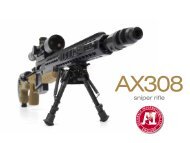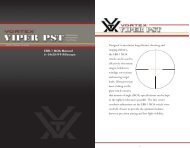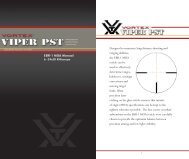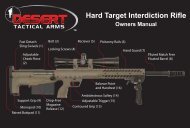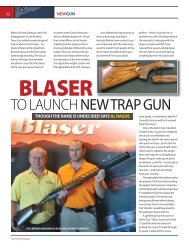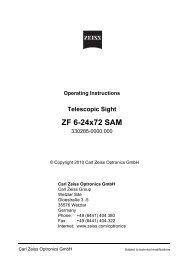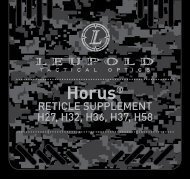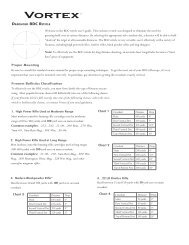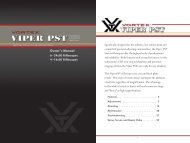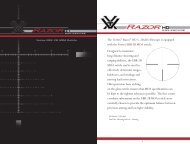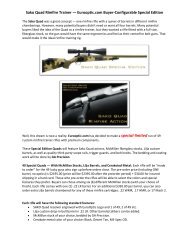Mark 23 Pistol .45 ACP - Heckler & Koch USA
Mark 23 Pistol .45 ACP - Heckler & Koch USA
Mark 23 Pistol .45 ACP - Heckler & Koch USA
- No tags were found...
Create successful ePaper yourself
Turn your PDF publications into a flip-book with our unique Google optimized e-Paper software.
<strong>Mark</strong> <strong>23</strong> <strong>Pistol</strong><strong>.45</strong> <strong>ACP</strong>WARNING:A firearm has the capability of taking your life or the life of someone else!Be extremely careful with your firearm. An accident can occur at anytimeand is almost always the result of not following basic safety rules.© <strong>Heckler</strong> & <strong>Koch</strong>, Inc.,All rights reserved.<strong>Heckler</strong> & <strong>Koch</strong>Specifications and models subject to change without notice.Revised March 2007Civilian Sales & Customer Service5675 Transport Blvd. Suite 200Columbus, GA 31907 <strong>USA</strong>Tel: (706) 568-9044Fax: (706) 568-9151Email: cs@hk-us.comWeb: www.hk-usa.comMilitary and Law EnforcementSales & Customer Service5675 Transport Blvd. Suite 200Ashburn, VA 31907 <strong>USA</strong>Tel: (703) 450-1900Fax: (703) 450-7078Web: www.heckler-koch.com
SAFETY RULESPlease read this operator's manual before handling your firearm. Thefollowing safety rules are placed in this manual by HKI as an important reminderthat firearm safety is your responsibility. Firearms can be dangerous and canpotentially cause serious injury, damage to property or death if handled improperly.1. Never point a firearm at anyone, or in any direction other than a SAFE direction;i.e., down range.2. Treat all firearms as if they are always loaded.3. Keep your finger off the trigger and outside of the trigger guard until your sights arealigned on the target and you are ready to fire.4. Keep your finger off the trigger and outside of the trigger guard while loading or unloadingthe firearm.5. Keep your finger off the trigger and outside of the trigger guard while pulling thefirearm out of the holster or while returning it to the holster.6. Be sure of your target and the backstop beyond.7. Never give a firearm to or take a firearm from anyone unless the action is open andthe magazine and/or chamber are free of any ammunition or brass.8. Be sure that the ammunition you are using is factory loaded, is of the correct caliberfor the firearm in which it is to be used, and that it is not damaged in any way.9. Before firing, remove the magazine from the firearm, lock the action open, makesure the chamber is clear of any ammunition or brass, and check the barrel of theunloaded firearm for any possible obstructions.10. Before firing any firearm that is unfamiliar to you, make sure that you understandexactly how it functions. A lack of familiarity with the firearm can result in a seriousaccident. Attend a certified training course on any firearm which you intend to use orwith which you are not sufficiently familiar.11. Always wear hearing and eye protection when using your firearm.12. Keep all body parts, especially hands and fingers, away from the muzzle to avoidinjury or burns.13. Be sure that no part of either hand touches or interferes with the slide. The slide ismoved backward by the recoil force of the pistol during firing and may cause seriousinjury.14. Firearms should be stored separately from ammunition and beyond the reach of childrenand/or any untrained individuals.15. Avoid the use of any alcoholic beverages or drugs before and during the use of anyfirearm.16. Discharging firearms in poorly ventilated areas, cleaning firearms, or handlingammunition may result in exposure to lead; a substance known to be associated withbirth defects, reproductive harm and other serious injury. Have adequate ventilation atall times. Wash hands thoroughly after exposure.
STOP! Know how to clear this pistol before attempting to operate.Clearing the <strong>Pistol</strong> - The HK <strong>Pistol</strong> is not considered “Clear” or safe unless:1. The magazine is removed from the pistol.2. The slide is locked to the rear.3. The chamber is free of brass or ammunition.To Clear the HK <strong>Pistol</strong>:1. Make sure fingers are outside of the trigger guard and the pistol is pointed in asafe direction at all times!2. Remove magazine - Depress the magazine release lever and remove the magazinefrom the pistol.3. Open and lock slide - While pointing the pistol in a safe direction, lock the slideopen by pulling the slide rearward as you press the slide release upward. Watch for acartridge or empty case to be ejected from the pistol.4. Inspect chamber - Inspect the chamber for the presence of a cartridge or emptycase by:• Visually viewing chamber through open ejection port.• Physically inserting finger into chamber through the ejection port to check for thepresence of a cartridge or empty case.Remove any cartridges or empty cases from the chamber or from within the pistol.The <strong>Mark</strong> <strong>23</strong> is now considered “Clear.”
TABLE OF CONTENTSPAGESection 1 Introduction 5General Information 5Section 2 Nomenclature 7Section 3 Principle of Operation 8Major Assembly Groups 8Section 4 Operating Instructions 9Initial Inspection 9General Description 9Operation & Characteristics 10Cycle of Operation 11Safety Features 13Section 5 Operation Under Normal Conditions 14Clearing Procedures 14Loading the Magazine 15Unloading the Magazine 15Readying the <strong>Pistol</strong> for Firing 16Firing the <strong>Pistol</strong> 17Section 6 Operation Under Unusual Conditions 17Extreme Cold 18Hot, Wet Climates 18Hot, Dry Climates 18Heavy Rain & Water Operations - All Climates 18Section 7 Malfunctions & Stoppages 19Remedial Action 19Section 8 Selection of Holster 19Section 9 Maintenance Instructions 20Tools & Equipment 20Operator Tools & Equipment Required 20Preventative Maintenance Procedures 20Disassembly (field stripping) 21Reassembly (from field strip) 22Safety/Function Check 24Function Firing 26Cleaning 26Inspection 27Lubrication 28Section 10 Adjustment of Sights 29Section 11 Troubleshooting Procedures 31Section 12 Ammunition 33Section 13 Parts Listing & Exploded Diagram 34Firearm Service Record 36
SECTION 1 INTRODUCTIONThe <strong>Mark</strong> <strong>23</strong> <strong>.45</strong> <strong>ACP</strong> pistol gives shooters match grade accuracy equal tothat of the finest custom made handguns — yet it exceeds the most stringentoperational requirements ever demanded of a combat handgun. The <strong>Mark</strong><strong>23</strong> provides this accuracy without the need for hand-fitted parts, common incustom-built match pistols costing thousands of dollars more. Repair of the <strong>Mark</strong><strong>23</strong> is reduced to a simple parts exchange.The <strong>Mark</strong> <strong>23</strong> is a commercial model of the U.S. Government issue MK <strong>23</strong>,MOD 0 pistol and is available in limited numbers. Designated the “<strong>Mark</strong> <strong>23</strong>,” itis almost identical to the MK <strong>23</strong>, MOD 0 pistol used by the Special OperationsCommand, right down to its threaded barrel. The main differences are slidemarkings (<strong>Mark</strong> <strong>23</strong> as opposed to MK <strong>23</strong>) and a barrel manufactured to SAMMIheadspace specifications. One of the most thoroughly tested handguns inhistory, the MK <strong>23</strong>/<strong>Mark</strong> <strong>23</strong> project originated in 1991 when HKI was awardeda development contract for the Special Operations Forces Offensive HandgunWeapon System, consisting of a <strong>.45</strong> caliber pistol, detachable sound and flashsuppressor, and laser aiming module (LAM).During testing, MK <strong>23</strong> pistols met the most stringent operational and accuracyrequirements ever demanded of a combat handgun. MK <strong>23</strong> pistols achievedmatch grade accuracy of less than a 2.5-inch maximum extreme spread in 5-round shot groups at 25 meters with service ammunition. Endurance testingdemonstrated a service life of over 30,000 rounds of +P ammunition with noparts breakage, with an additional 30,000 rounds certified on the slide andframe.To meet the reliability requirement, the pistol had to demonstrate a minimumof 2,000 mean rounds between stoppages (MRBS) with both M1911 ball and+P ammunition. The minimum MRBS achieved in testing was 6,027 and themaximum was 15,122! Out of over 450 accuracy test firings from a precisionfiring fixture, MK <strong>23</strong> pistols far exceeded the government requirement, averaging1.44 inches with 65 groups of less than one inch. There were four groups of .5inches with 5 rounds going through the same hole! This included firing with andwithout the sound/flash suppressor attached.Three pistols were tested for accuracy after firing over 30,000 rounds, thespecified service life of the pistol, and still met the new pistol accuracyrequirement. An innovative design feature, a high temperature rubber O-ring onthe barrel that seals the barrel in the slide until unlocking, led to this remarkableachievement. The O-ring lasts beyond 20,000 rounds and can be replacedby the operator without tools in seconds. To meet operational environmentalrequirements, the pistol was function tested at +140 and -250 F, immersed insalt water, exposed to surf, salt-fog, sand-dust, mud, unlubricated and a variety
of other fouled environments. A special maritime surface coating protects thepistol from corrosion in all of these operational environments.The barrel is threaded to accept accessories such as a flash and soundsuppressor. The unique HK polygonal bore profile increases muzzle velocity andservice life, reduces bore fouling and eases cleaning. The frame mounted <strong>Mark</strong><strong>23</strong> decocking lever is separate from the ambidextrous safety lever. It allows thehammer to be lowered quietly and safely from the single-action position. Whenthe hammer is down, the ambidextrous frame-mounted safety lever is locked inthe fire position so that the pistol is always ready for double-action operation.When the hammer is “cocked and locked” in single-action mode with the safetylever on “safe,” the decocker is blocked so that the pistol is always ready forsingle-action operation. Even with the safety lever engaged, the slide can still bemanipulated to load and clear the pistol.The extended slide release lever and the ambidextrous magazine release areeasily operated without adjustment of the firing grip using the thumb or indexfinger of the firing hand. Other notable features include: accessory mountinggrooves on the frame, a mechanical recoil reduction system that reducesrecoil forces to the shooter and components of the pistol by as much as 30%,a polymer frame, a one-piece machined steel slide, and a 12-round magazinecapacity. The weapon is aimed using either iron sights or an optional laseraiming component. The iron sights provide a 3-dot sight picture with white oroptional self-luminous tritium dots. The MK <strong>23</strong> became the first <strong>.45</strong> <strong>ACP</strong> caliberpistol to enter U.S. military service since the venerable Government Model1911A1. On May 1, 1996, the first MK <strong>23</strong> pistols were delivered to the U.S.Special Operations Command for operational deployment.
SECTION 2 NOMENCLATUREthreaded barrelsliderecess for sliderelease/stopslide releaserear sighthammerleft safey leveraccessory mountinggroovethreaded insertfor accessorymagazinelockingreleaseflared triggerguarddecocking leverframemagazineLeft View (Figure 1)<strong>Mark</strong> <strong>23</strong> <strong>Pistol</strong> Specifications_________________________________________________________________________________________Caliber<strong>.45</strong> <strong>ACP</strong>Operating PrincipleShort recoil, semiautomaticAction TypeModified Browning type, linkless________________________________________________________________SightsFixed patridge style, adjustable forwindage & elevation, standard 3-dot oroptional tritiumTotal Length9.65 in. (245mm)Barrel Length5.87 in. (149mm)Sight Radius7.76 in. (197mm)Twist Length378 mm (14.88 in.)________________________________________________________________Height without magazine5.90 in. (150mm)Width of Frame1.58 in. (38.8mm)Weight (with empty 12-round magazine) 2.66 lbs. (1.21 kg)Weight of empty 12-round magazine .81 lbs. (.366 kg)Weight of empty 10-round magazine .72 lbs. (.327 kg)Slide Force (to retract slide)8.5 kg (18.74 lbs.)________________________________________________________________Trigger Pull Single-action4.85 lbs. (2.20 kg)Trigger Pull Double-action12.13 lbs. (5.50 kg)Magazine Capacity(does not include cartridge in chamber)Safety Features* Specifications and models subject to change without notice.10 or 12 cartridges, <strong>.45</strong> <strong>ACP</strong>Double-action mode with hammerintercept notch, Firing pin block,Disconnector
SECTION 3 PRINCIPLE OF OPERATIONA. The <strong>Mark</strong> <strong>23</strong> uses a modified linkless Browning-style short recoil system tolock and unlock the breech.B. Upon firing, the pressure developed by the propellent gas forces the slide andbarrel assembly to the rear. After approximately 3mm, the locking block willstop the rearward movement of the barrel as the barrel is pivoted downwarddue to the engagement of the angled surfaces of the locking block with thoselocated in the recoil spring guide rod. The locking block will disengage fromthe slide and the slide will continue rearward.The extractor located in the slide will then extract the fired cartridge case.The ejector located in the frame on the left side of the magazine well willeject the fired case as the slide continues rearward and cocks the hammerand compresses the recoil spring. The slide moves forward feeding thenext cartridge from the magazine into the chamber and locking to the barrelbreech.C. The slide locks open after the last round has been fired and ejected.WARNING: Do not rely on the slide lock to determine if the magazine isempty. Always check visually and physically to ensure the pistol is notloaded.Major Assembly Groups (see Figure 3)A. Slide - Houses the firing pin, firing pin block and extractor; cocks hammerduring recoil.B. Captured Recoil/Buffer Spring Assembly (with guide rod) - Absorbs recoil andreturns the slide and barrel to their forward positions; reduces impact of slideon receiver during recoil. The recoil spring is “captured” by a C-clip on the endof the guide rod.C. Threaded Barrel (with locking block) - Contains cartridge and propellentgases during firing. The locking block initiates locking and unlocking of thebreech during movement of slide. The O-ring holds the barrel tight in the slideuntil unlocking.D. Frame - Serves as support to all major components; controls functioning ofpistol. The slide release locks the slide with barrel and recoil/buffer springassembly to the metal locking insert cast into the synthetic frame. A lanyardloop is in the bottom of the grip for attaching a lanyard. The trigger guard isflared on both sides to preclude accidental actuation of the magazine releaseduring holstering.E. Magazine - Holds the cartridges in position for feeding and chambering.
F. Slide Release - Holds slide to rear when engaged; releases slide when leveris depressed.Figure 3SECTION 4 OPERATING INSTRUCTIONSSERVICE UPON RECEIPT OF MATERIALInitial Inspection. Upon initial receipt, the pistol is to be inspected to ensure itwas received in proper working order.Step Action Reference1 Remove pistol and items from container2 Remove packing material3 Check for missing items4 Field strip weapon and inspect for: para. 3.3Missing partsProper assembly5 Clean, dry and lubricate (if necessary) para. 3.7, 3.96 Assemble para. 3.47 Safety/function check para. 3.5GENERAL DESCRIPTIONThe <strong>Mark</strong> <strong>23</strong> is a semiautomatic, magazine fed, recoil operated, double/singleactionpistol, chambered for the <strong>.45</strong> <strong>ACP</strong> cartridge, up to and including thecommercial +P cartridges.WARNING: The <strong>Mark</strong> <strong>23</strong> incorporates single and double-action modesof operation. Anytime the trigger is pulled with the safety lever in the fire(down) position and a round in the chamber, the pistol will fire from eitherthe hammer down (DA) or cocked position (SA).
CAUTION: A pair of Universal Mounting Grooves located on the front of the<strong>Mark</strong> <strong>23</strong> frame allow for a variety of accessories to be used with the pistol.Improperly designed or installed accessories may result in damage to the<strong>Mark</strong> <strong>23</strong> mounting grooves and/or the <strong>Mark</strong> <strong>23</strong>. Such damage is not coveredunder warranty. Be certain to use only HKI authorized accessories andfollow installation and precautions carefully.NOTE: Accessories designed for the Universal Self-loading <strong>Pistol</strong> (USP) willnot work on the Universal Mounting Groves of the <strong>Mark</strong> <strong>23</strong>.Operation and CharacteristicsA. Double/Single Action - For double-action (DA), pulling the trigger will cockthe hammer and immediately release it, discharging a chambered round. To firethe first chambered round in single-action (SA), the hammer must be manuallycocked before pulling the trigger. All shots after the first one will be fired singleactionbecause the slide automatically recocks the hammer after each shot.B. Magazine - The magazine is produced from sheet steel and has a totalcapacity of 12 rounds. The rounds are positioned within the magazine in astaggered arrangement. Rounds are visible through the viewing holes locatedalong the back side of the magazine housing. The viewing holes are marked withnumerals denoting the number of rounds remaining within. The floorplate can beeasily removed for disassembly and cleaning of the magazine components.C. Loaded Chamber Indicator - The <strong>Mark</strong> <strong>23</strong> pistol does not have a loadedchamber indicator. The extractor does not act as a loaded chamber indicator.D. Decocking Lever - The decocking lever allows the operator to quietly lowerthe cocked hammer without concern of an accidental discharge. When thehammer is cocked, it may be lowered safely by moving the decocking lever fullyinto the decocking (down) position. The decocking lever cannot be depressed(and therefore does not allow the hammer to be lowered) if the safety lever isengaged. The decocking lever always springs back into its disengaged (up)position due to the spring pressure exerted by the decocking spring.E. Safety Lever - The safety lever is an ambidextrous “thumb” lever located onthe rear of the frame. It is actuated by the firing thumb of the operator. The safetylever blocks the release of the cocked hammer when it is in the engaged (up)“safe” position (see Figure 4a). The safety lever is depressed downward intothe “fire” position (see Figure 4b). The safety lever is not spring actuated andtherefore must be moved manually from one position to the other by the operator.Figure4a “Safe”PositionFigure 4b “Fire”Position: Thesafety lever cannotbe placed in the“safe” (up) positionif the hammer isuncocked (down).10
WARNING: The pistol should always be carried with the safety leverengaged when carried in the single-action mode. While there is a springdetent to prevent this, the safety lever can be moved to the "fire" position(down) with a minimal amount of force. This could happen during carelesshandling or during removal of the pistol from the holster. Always check theposition of the safety lever during handling.F. Frame - The front and back straps of the fiberglass reinforced polymer frameare checkered to ensure a firm grip, even with wet hands or under conditions ofrapid fire. The trigger guard is extended, recurved and grooved to provide a firmgrip when using two hands or gloves. The bottom of the trigger guard is flaredon both sides in front of the magazine release lever to shield the lever fromaccidental actuation.A threaded insert is molded into the front face of the trigger guard and the frameis grooved forward of the trigger guard for attachment of an accessory suchas a laser aiming device or an illuminator. The frame is a one-piece moldedcomponent with metal inserts (locking insert and guiding part) cast into theframe during production. The slide rides on these metal inserts during operation.G. Slide Release Lever - This lever is used to lock the slide open and fordisassembling the weapon. As a slide stop, it is depressed upward by themagazine follower or the operator’s finger as the slide travels rearward duringrecoil or manual operation. The slide release lever engages the recess visibleon the left side of the slide and is spring actuated. The slide release springholds the slide release lever in a disengaged (down) position until required. Asa disassembly lever, the slide release lever is removed from the left side of theframe when the slide is held rearward. The slide release lever can be actuatedby the firing thumb of the right handed operator or the index finger of the lefthanded operator.H. Magazine Release Lever - This ambidextrous spring actuated lever holdsthe magazine within the grip by engaging in the notch found in the upper third ofthe magazine housing. Depressing this lever with the firing hand index finger orthumb will allow the magazine to drop from the grip. The magazine release leveris shielded from accidental actuation by the flared trigger guard and the designof the synthetic frame surrounding the lever.Cycle of Operation begins with weapon loaded, hammer cocked and safetylever disengaged.Figure 5Firing11
A. Firing - (see Figure 5) Pulling the trigger rearward pulls the trigger barforward. The trigger bar pivots the sear actuator upward which disengages thefiring pin block. At the same moment, the sear is pivoted out of engagement fromthe lower of the two shelves located on the hammer. The compressed hammerspring drives the hammer forward into the rear end of the firing pin. The firingpin strikes the primer of the chambered round. The propellent is ignited by theprimer and propellent gases are created inside the cartridge case. The propellentgases drive the projectile down the polygonal bore which spins the projectile in aclockwise direction as a means to stabilize the projectile’s flight.B. Unlocking - (see Figure 6) The gas pressure and energy produced by thepropellent gases push rearward on the slide, which is locked to the barrel bythe engagement of the barrel locking block within the ejection port milled intothe slide. The opposing angled locking surfaces incorporated into the design ofthe barrel locking block and recoil spring guide rod cause the rear of the barrelto tilt downward as the slide moves rearward. By the time the slide and barrelhave recoiled approximately 5mm, the projectile has left the barrel and the gaspressure within the chamber has dropped to a safe level. The barrel lockingblock then disengages from the slide. The slide is now free to recoil rearwardindependently of the barrel.Figure 6 Figure 7C. Extraction - The empty cartridge case is held firmly against the face of theslide by the claw of the extractor as the slide recoils rearward.D. Ejection - (see Figure 7) - The rim of the cartridge case strikes the stationaryejector. The empty case is ejected from the open ejection port.E. Cocking - (see Figure 7) - As the slide continues rearward the recoil impulseis dampened by the buffer spring. The recoil spring is compressed and thehammer recocked.F. Feeding - (see Figure 8) - The compressed recoil spring drives the slideforward. If the magazine is empty, the magazine follower will lift the slide releaseto a point where it will stop the forward progress of the slide. If the magazineis not empty, the face of the slide will make contact with the top round in themagazine. The round will be driven from the magazine toward the chamber.The tip of the projectile is guided into the chamber by the magazine lips until theround clears the magazine completely. At that moment the claw of the extractorsnaps onto the rim of the cartridge case as it becomes parallel with the bore.12
G. Chambering - The slide pushes the cartridge forward until the projectileenters the mouth of the forcing cone of the bore and the face of the slidecontacts the rear of the barrel locking block.H. Locking - (see Figure 5) - The slide presses the barrel forward. As it does,the opposing angled surfaces of the barrel locking block and recoil spring guiderod pivot the rear end of the barrel up into engagement with the ejection port inthe slide. The slide is now fully forward and the new round is ready to be fired.Safety FeaturesA. Safety Lever - This safety blocks the release of the cocked hammer in the SAmode. The safety lever is an external, manually operated, ambidextrous “thumb”lever located on the left and the right side of the frame further most back fromthe trigger. The safety lever must be manually actuated by the operator. Theshaft of the safety lever moves the sear block into a position where it blocks themovement of the sear actuator. The sear actuator, in turn, does not allow thesear to pivot forward and thus the hammer cannot be released. Engaging thesafety lever also interrupts the function of the decocking lever and blocks thehammer mechanically. The safety lever does not restrict the movement of theslide. The safety lever is held in either the fire or safe position by a spring detent.The safety lever cannot be placed in the safe (up) position when the hammer isdown (uncocked).B. Double-Action Mode - This safety keeps the hammer in an uncockedcondition until the moment of firing. The double-action mode operates as apassive safety feature in the pistol, much as this mode of operation would in anyDA revolver or pistol. The hammer is left uncocked until the decision to fire ismade. At all times, the firing pin is locked by the firing pin block until the triggeris pulled. Approximately 12.1 pounds of pressure on the trigger is requiredto cock and release the hammer in the DA mode of operation. The mode ofoperation also permits subsequent hammer strikes on the same chamberedround by simply resqueezing the trigger.C. Firing Pin Block - This safety prevents the firing pin from striking the primerwhen the weapon is dropped, the hammer is bumped, or when the slide slamsforward. The firing pin block is located in the slide and blocks the forwardmovement of the firing pin. Only when the trigger is depressed can the searactuator push the firing pin block upward against the downward pressure exertedby the firing pin block spring. Once the round has been fired and the slide beginsto recoil, the firing pin block is pushed back down by the firing pin block spring13
and engages within the recess provided in the center portion of the firing pin.D. Disconnector - This safety prevents the release of the hammer unless theslide is fully forward and/or the trigger is reset (released) between rounds.This important safety prevents serious malfunctions from occurring, such as“slamfires” (rounds that fire during loading), automatic fire, or a round beingfired out of the battery (with the breech unlocked). The disconnector disconnectsthe engagement of the trigger bar and the sear actuator. The disconnectoris engaged (operating) after the slide has moved 2mm to the rear. The slidepresses the leading edge of the disconnector down and into engagementwith the trigger bar. When the slide is fully forward, the leading edge of thedisengaged disconnector resides in a recess provided in the bottom of the slide.SECTION 5 OPERATION UNDER NORMAL CONDITIONSWARNING: Always clear the pistol before handling it.Clearing ProceduresA. The <strong>Mark</strong> <strong>23</strong> pistol is not considered “clear” or safe unless:1. The magazine is removed2. The slide is locked to the rear3. The chamber is free of brass or ammunition4. The safety lever is set on “Safe”NEVER ASSUME THE PISTOL IS CLEAR!B. To Clear the <strong>Pistol</strong>:1. Make sure fingers are outside of the trigger guard and the pistol ispointed in a safe direction at all times!2. Decock Hammer or Engage Safety - Depress decocking lever orengage the safety lever.3. Remove Magazine - Depress the magazine release lever and removethe magazine from the frame.4. Open Slide - Lock slide open by pulling slide rearward as you engagethe slide release lever (up). Watch for live round or empty case to beejected.5. Inspect Chamber - Inspect chamber for the presence of a live round orempty case:a. Visually view chamber through ejection port.b. Physically insert finger into chamber through ejection port andcheck for presence of cartridge case in chamber.c. Remove any live rounds or empty cases from the chamber orfrom within the weapon.The pistol is now considered “Clear.”14
Loading and Unloading the Magazine - (see Figure 9)The <strong>Mark</strong> <strong>23</strong> pistol is available with either 10 or 12-round magazines.A. Loading the Magazine -1. Hold the magazine in one hand.2. Hold a round between the index finger and thumb of the other hand with theprojectile pointing towards the palm.3. Press the rim of the round down against the front edge of the follower or thetop round in the magazine and slide the round back under the magazinelips.4. Repeat steps 1-3 until the magazine is full. The viewing holes in the backof the magazine allow the operator to confirm the number of rounds presentwithin the magazine.WARNING: Forcefully inserting a loaded magazine into the <strong>Mark</strong> <strong>23</strong> maycause the pistol's slide to close, chambering a cartridge and making the<strong>Mark</strong> <strong>23</strong> ready to fire. When inserting a magazine, always be certain thatthe pistol is pointed in a safe direction with your fingers off the triggerand outside the grigger guard. Failure to do so could cause you tounintentionally fire the pistol, resulting in serious injury or death.Figure 9B. Unloading the Magazine - Exert pressure with the finger on the base of thecartridge case and push each round forward out of the magazine one round at atime until the magazine is empty.Loading ProcedureA. Administrative Loading - Used to initially load the pistol before it is tobe fired.Method A (Slide rearward, chamber empty)1. Make sure fingers are outside of trigger guard and pistol is pointed in asafe direction at all times!2. Insert magazine firmly into the frame. Tug on magazine to insure that it isfully seated and engaged.3. Depress the slide release lever to release the slide and to chamber thefirst round.4. Engage safety lever or depress decocking lever.5. Remove magazine and top off with one additional round.15
6. Reinsert magazine insuring that it is fully seated.Method B (Slide forward, chamber empty)1. Make sure fingers are outside of trigger guard and pistol is pointed in asafe direction at all times!2. Insert magazine firmly into the frame. Tug on magazine to insure that it isfully seated and engaged.3. Retract the slide fully and release. Do not ride slide forward!4. Engage safety lever or depress decocking lever.5. Remove magazine and top off with one additional round.6. Reinsert magazine insuring that it is fully seated.B. Tactical Reloading - Used to quickly reload pistol once firing has begun.Method A (Slide rearward, chamber empty)1. Make sure fingers are outside of trigger guard and pistol is pointed in asafe direction at all times!2. Keep eyes on target area.3. Depress the magazine release with finger or thumb of firing hand to dropmagazine.4. At the same time, retrieve a full magazine with the non-firing hand andinsert firmly into the frame. Tug on magazine to insure that it is fullyseated and engaged.5. Depress slide release to chamber first round.6. Continue firing.Method B (Slide forward, rounds remaining in magazine and chamber)1. Make sure fingers are outside of trigger guard and pistol is pointed in asafe direction at all times!2. Keep eyes on target area.3. Depress the magazine release with finger or thumb of firing hand to droppartially empty magazine.4. At the same time, retrieve full magazine with non-firing hand and insertfirmly into the frame. Tug on the magazine to insure that it is fully seatedand engaged.5. Weapon is now back at full capacity without rendering chamber emptyand weapon useless.6. Continue firing.Readying the <strong>Pistol</strong> for FiringDisengage the safety lever (if engaged). Red hazard dot will be visible abovesafety lever.16
WARNING: (1) BE SURE OF YOUR TARGET AND WHAT IS BEHIND IT! Evena <strong>.45</strong> caliber projectile can easily penetrate wood, plasterboard walls, ora car door, and can travel as far as one mile! (2) Ensure that all parts ofyour hand and body are kept away from the muzzle of the pistol at all time!(3) Always wear eye and ear protection where possible when firing thepistol. (4) Whenever the pistol is dropped on a hard surface landing on thehammer (cocked or down), it should be sent to the HKI Customer ServiceDepartment as soon as possible to inspect the sear axle. If the sear axle isbent it should be replaced.Firing the <strong>Pistol</strong>A. Single-action mode (Hammer back/cocked) affords the operator the best andlightest trigger pull (4.8 lbs.) for precise and accurate bullet placement.With manual safety disengaged:1. Aim at the target.2. Fire the weapon by pressing the trigger straight to the rear with graduallyincreasing pressure.3. Engage the safety lever to remain in the single-action mode once firing iscompleted.CAUTION: Single-action mode trigger pull is lighter and shorter thandouble-action mode. Keep your finger off the trigger and outside the triggerguard except when firing the <strong>Mark</strong> <strong>23</strong>.B. Double-action mode (Hammer down/uncocked) provides the operator with along, heavy (12.1 lbs.) trigger pull for the first shot only. Subsequent shots will befired in single-action mode as the slide will automatically cock the hammer aftereach round is fired. The double-action mode of fire is often the preferred modeof fire when safety during handling and carrying is of greater concern than firstround accuracy.1. Aim at the target.2. Fire the weapon by pressing the trigger straight to the rear with graduallyincreasing pressure.3. Depress the decocking lever to lower the hammer to return to the doubleactionmode once firing is complete, or engage the safety lever to remain inthe single-action mode.SECTION 6 OPERATION UNDER UNUSUAL CONDITIONSNOTE: Unusual conditions are defined as any climatic condition requiringspecial maintenance of the pistol. Perform the maintenance outlined for theclimate that most applies to your operational area. Refer to paragraph 3.9for lubrication instructions.17
CAUTIION: If extensive corrosion is found and cleaning does not solve theproblem, contact the HKI Customer Service Department at (706) 568-9044.Extreme ColdA. When operating the pistol in extremely cold climates, clean and lubricate thepistol inside at room temperature if possible.B. Apply a light coat of LAW (Lubricant, Arctic Weapons) to all functional parts.C. To prevent freezing, keep the pistol covered when moving from a warm to acold area. This will allow gradual cooling.D. Always keep the pistol dry.E. Do not lay a hot pistol in snow or ice.F. Keep ammunition dry; moisture will cause malfunctions. Do not lubricate theammunition.G. Always keep snow out of the bore of the barrel. If snow should get into thebore, clean the bore before firing using a swab and cleaning rod.Hot, Wet ClimatesA. Perform maintenance more frequently. Inspect hidden surfaces for corrosion.If corrosion is found, clean and lubricate.B. To help prevent corrosion, remove hand prints with a cloth. Dry and lubricatethe pistol with CLP/LSA (Cleaner, Lubricant, Protectant).C. Check ammunition and magazines frequently for corrosion. Clean themagazine using CLP/LSA and wipe dry with a cloth. If necessary, cleanammunition with a dry cloth.D. Always keep mud out of the barrel. If mud should get into the bore, clean itbefore firing using a swab and cleaning rod.Hot, Dry ClimatesA. Dust and sand will get into pistol and cause malfunctions and excessive wearon component contact surfaces during firing. Keep the pistol covered whenpossible.B. Corrosion is less likely to form on metal parts in a dry climate. Therefore,lightly lubricate internal working surfaces only with CLP/LSA. Do not lubricateexternal parts of the pistol. Wipe any excess lubricant from exposed surfaces.Do not lubricate internal components of magazine.Heavy Rain and Water Operations - All ClimatesA. Perform maintenance in accordance with the appropriate climatic conditions.B. Always attempt to keep pistol dry.C. Always try to drain any water from barrel prior to firing. Dry the bore with aswab and cleaning rod.D. Lightly lube the bore and chamber. Generously lube internal and externalsurfaces of the pistol with CLP/LSA.E. In extreme or prolonged wet or saltwater conditions, cover serial number andproof mark on barrel and slide with a temporary protective coating. These areetched on the permanent protective coating on the barrel and slide and thereforemay corrode under these conditions.18
SECTION 7 MALFUNCTIONS AND STOPPAGESRemedial Action - Remedial Action is the action performed to remedy anunanticipated interruption of the pistol’s operation and place the pistol back intooperation.WARNING: During remedial action, make certain the pistol is pointed in asafe direction at all times.A. Clear the pistol!B. Attempt to lock slide.C. Remove magazine.D. Inspect chamber.E. Insert fresh magazineF. Release slide.G. Attempt to fire the pistol. If the <strong>Mark</strong> <strong>23</strong> fails to fire, contact the HKI CustomerService Department at (706) 568-9044 568-WARNING: If a round is assembled without powder (a fault of themanufacturing process), the primer alone has enough power to propel theprojectile into the bore. A projectile lodged in the bore may cause damageto the barrel and/or the pistol if another round is fired and could causepersonal injury. This event is commonly called a "pop and no kick" or"squib load" and is characterized by a much reduced report and little or nomovement of the slide. An alert operator should notice the occurrence ofthis event in time to avoid firing the next round.SECTION 8 SELECTION AND USE OF A HOLSTERSelection - When selecting a carrying holster for the HK <strong>Mark</strong> <strong>23</strong>, it is importantto consider the following points:1. The holster must not make contact with or actuate any of the operatingcontrols. This includes the hammer, slide release, magazine release lever, andmost importantly the safety lever and the trigger. The design of the holster mustalso not actuate these controls when the pistol is carried in, drawn from, orreturned to the holster.2. The holster should not cause the slide to move (unlock) when the pistol isreturned to the holster.3. Accommodations must be provided in the holster for any accessories thatmight be present on the pistol.4. Choose a holster designed for the <strong>Mark</strong> <strong>23</strong>.Returning the <strong>Pistol</strong> to the Holster - The HK <strong>Mark</strong> <strong>23</strong> must be made “safe” (orcleared) prior to returning it to the holster. The pistol is considered safe to returnit to the holster when:1. All fingers are off of the trigger and out of the trigger guard.2. The pistol is “Clear.”3. The hammer is in the decocked (down) position.19
4. The safety lever is engaged in the safe position when the hammer iscocked.WARNING: The pistol must never be returned to the holster unless theabove procedures have been followed or injury or death could occur.SECTION 9 MAINTENANCE INSTRUCTIONSTOOLS & EQUIPMENT NOTE: The service life and performance of your HK<strong>Mark</strong> <strong>23</strong> is dependent upon the correct handling and proper care by the operator.Operator Tools and Equipment Required.At a minimum, you will require the following materials to maintain the <strong>Mark</strong> <strong>23</strong>pistol and its components:• Cleaning rod with handle and eyelet• Long-handled nylon brush• Bronze bristle bore brush (<strong>.45</strong> caliber)• Cotton swabs• Solvent/bore cleaner/CLP• Cleaning patches (<strong>.45</strong> caliber)• RagCAUTION: Use safety goggles when using solvents and exercise care ifusing compressed air.PREVENTATIVE MAINTENANCE (PM) SERVICE CHECKS & MAINTENANCEPROCEDURESGeneral - This PM service section lists those required checks and servicesto be performed by personnel who operate the <strong>Mark</strong> <strong>23</strong> pistol. This sectionincludes the services required to prepare the pistol for operation, to check thepistol during operation, and to ensure proper function after maintenance. Beforeperforming any PM service procedures, ensure that the Firearm Service Recordhas been updated with the correct round count and any PM service proceduresdocumented. If your equipment fails to operate, refer to the TroubleshootingTable in Section III.WARNING: Before starting an inspection procedure CLEAR THEPISTOL! Inspect the chamber to ensure that it is empty. Do not keep liveammunition near maintenance/work areas.20
Figure 10Removing or Installing the Slide ReleaseCAUTION: Hold the recoil/buffer spring assembly in place while removingthe slide from the frame.NOTE: Before starting any PM service procedure, ensure that the FirearmService Record has been updated with the corect round count and any PMservice performed documented.Disassembly (field stripping)A. <strong>Pistol</strong>1. Clear the pistol!2. Depress slide release and allow slide to move forward.3. If applicable, remove any mounted accessories.4. Using the left hand, retract and hold the slide to the rear approximately22mm until the front end of the slide release is centered on the recessvisible on the left side of the slide (see Figure 10).5. With the right hand, push the slide release into the recess on the rightside of the frame. Lift and completely remove the slide release from theleft side of the frame.6. Remove the slide with barrel and captured recoil/buffer spring assemblyoff of the frame by sliding it forward.7. Remove the captured recoil/buffer spring assembly from the barrel andslide by lifting up on the rear of the guide rod. The entire assembly cannow be lifted out of the slide.8. Lift the rear of the barrel by the locking block and withdraw it from theslide.B. Magazine12-Round Magazine1. Using a blunt pointed instrument, depress the locking detent protrudingthrough the bottom of the magazine floorplate and hold it there.2. Place a portion of either hand over the base of the magazine to controlthe release of the magazine spring and locking plate.3. Slowly slide the floorplate forward off of the magazine housing.21
4. Gradually allow the locking plate and magazine spring to expand out ofthe magazine housing.5. Remove the locking plate, magazine spring and magazine follower fromthe magazine housing.10-Round Magazine1. Using a blunt pointed instrument depress the locking insert detentelocated in the floorplate and hold it there.2. Place a portion of either hand over the base of the magazine to controlthe release of the magazine spring and locking insert.3. With the locking detente still depressed, squeeze the floorplate lockingtabs located on the right and left sides of the magazine.4. Gradually allow the locking insert and magazine spring to expand out ofthe magazine housing.5. Remove the locking insert, magazine spring and magazine follower fromthe magazine housing.CAUTION: Beware of the spring tension exerted by the magazine springwhile removing and installing the magazine floorplate. Keep the base ofthe magazine pointed in a safe direction (away from face and eyes) duringdisassembly and assembly.CAUTION: Operator disassembly of the <strong>Mark</strong> <strong>23</strong> pistol is now complete.Only trained HKI personnel may disassemble the weapon further.Reassembly (from field strip)A. Magazine (12-Round)1. Place the magazine follower onto the end of the magazine spring havingthe loop at the end of the wire on the left side of the follower.2. Insert the follower and the magazine spring into the magazine housing.3. Place the locking plate onto the protruding end of the magazine spring sothat the locking detent is visible (see Figure 11A).4. Push the locking plate down into the magazine housing against thepressure of the magazine spring and hold it there.5. Slide the floorplate over the base of the magazine housing and lockingplate from front to rear making sure that:a. The floorplate engages the tabs located on the left and right sidesof the magazine housing.b. The floorplate is fully seated on the magazine housing.c. The locking detent fits within the hole provided in the floorplated. Check the magazine for proper assembly by insuring that thefollower slides up and down freely within the magazine housingand with spring tension. Also check that the magazine followerrises within the housing to be nearly flush against the bottom of themagazine lips.22
Figure 11AAssembly of Magazine Follower & Spring (12-Round Magazine)Figure 11B10-Round Magazine (Disassembled)10-Round Magazine (see Figure 11B)1. Place the magazine follower onto the magazine spring with the end of thespring positioned on the left of the follower.2. Insert the follower and magazine spring into the magazine housing.3. Place the locking insert (on 10-round magazines) onto the protruding endof the magazine spring so that the rounded corners face toward the frontof the magazine.4. Push the locking plate down into the magazine housing against thepressure of the magazine spring and hold it there.5. Push the floorplate up onto the base of the magazine housing until thelocking tabs engage in the sides of the housing. Check to see if thelocking tabs on the floorplate are securely locked into the housing and thelocking detente on the locking plate fits within the hole in the floorplate.6. Check the magazine for proper assembly by insuring that the followerslides up and down freely within the magazine housing and with springtension. Also check that the magazine follower rises within the magazinehousing to be nearly flush against the bottom of the magazine lips.B. <strong>Pistol</strong>1. Insert the muzzle of the barrel through the large hole located in the front ofthe slide.2. Drop the barrel down into the slide and push it forward until the O-ringengages the slide, the locking block fits within the ejection port, and theangled locking surface of the locking block are visible along the bottom ofthe slide. The O-ring will now hold the muzzle tight in the front of the slide.3. Install the captured recoil/buffer spring assembly into the slide so that thefront of the recoil spring guide rod engages in the smaller hole located inthe front of the slide.<strong>23</strong>
4. Align the opposing angled locking surfaces of the recoil spring guide rodwith those located on the bottom of the barrel locking block.5. Push the rear of the recoil/buffer spring assembly forward enough so thatthe recoil spring retainer can be engaged on the shelf provided on thefront of the barrel locking block (see Figure 12).6. Hold the slide in the right hand with the thumb holding the rear end of therecoil/buffer spring assembly in place on the slide (see Figure 13).7. Hold the frame in the left hand. Position the rear of the slide above thefront edge of the frame.8. Draw the slide back onto the frame so that the rails of the locking insertand guiding part slide within the grooves in the slide.9. Retract the slide to the point where the recess in the left side of the slideis centered on the hole where the axle of the slide release will go.10. Hold the slide in this position and insert the slide release from the left toright into the frame until it is flush with the side of the frame and locks inplace.Figure 12 - Proper Position for the Captured Recoil/Buffer Spring Assembly onthe Barrel Locking BlockFigure 13 - Correct Position for Holding Slide for ReassemblyNOTE: Operator reassembly of the <strong>Mark</strong> <strong>23</strong> pistol is now complete, but notfinished without a safety/function check.Safety/Function CheckA. A safety/function check should be performed anytime the pistol isreassembled. This quick check indicates whether or not the pistol wasproperly assembled and with all the components. A properly executed safety/function check can also reveal many of the more obvious malfunctions thatcould occur between the interactive components of the pistol.B. Always clear the pistol before performing a safety/function check! Don’tassume the pistol is clear!1. Clear the pistol!2. Actuate the slide and the operating controls to insure that:a. Magazine and catch - The magazine is held securely in place by24
the magazine catch and that it drops free of the frame when thecatch is depressed.b. Slide - The slide moves freely and without binding on the frame(with and without a magazine installed).c. Barrel - The barrel locking block does lock fully into battery withinthe ejection port of the slide as the slide is closed.d. Slide Release -1) The slide release does hold the slide open whenretracted while:a) an empty magazine is in placeb) the slide release is engaged (pressed upwards)2) The slide release does permit the slide to snap forward when:a) the slide release is depressedb) the slide is retracted without a magazine installed2) The slide release does rebound with spring pressure3. Perform the following safety checks:a. Safety Lever Test.1) With the pistol unloaded and hammer down (uncocked),attempt to press the safety lever upward into the safe position.The safety lever should not engage. If the safety leverengages, return the pistol to the HK Service Department forservice.2) With the pistol unloaded and the hammer cocked, move thesafety lever several times from the “safe” to “fire” position. Ifthe safety lever does not have a pronounced stop when movedfrom “safe” to “fire” position and back, return the pistol to theHK Service Department for service.3) With the pistol unloaded, cock the hammer and press thesafety lever upward into the safe position. Grasp the pistol inthe shooting position and squeeze the trigger three or fourtimes. If the hammer falls, return the pistol to the HK ServiceDepartment for service.b. Decocking Lever Test1) With the pistol unloaded, cock the hammer and depress thedecocking lever. If the hammer does not fall or the decockinglever does not rebound (upward into its normal position) withspring pressure, return the pistol to the HK Service Departmentfor service.2) With the pistol unloaded, cock the hammer and press thesafety lever upward into the safe position. Attempt to depressthe decocking lever three or four times. If the hammer falls,return the pistol to the HK Service Department for service.c. Decocked (hammer down) TestNOTE: On the <strong>Mark</strong> <strong>23</strong> pistol when decocked (hammer down), the sear isengaged with the hammer at a rebounded stop position not touching therear of the firing pin.1) With the pistol unloaded, squeeze the trigger allowing the25
Function Firinghammer to cycle in the double-action mode. After the hammerdrops, retain pressure on the trigger. With the non-firing handapply pressure with your finger tips on the rear of the hammer.The hammer should move forward toward the firing pin.Release pressure on the trigger while still retaining pressurewith fingers on hammer. Release pressure on hammer. If thehammer fails to spring back into the stop position, return thepistol to the HKI Service Department for service.2) With the pistol unloaded, hammer uncocked and triggerforward, apply pressure to the hammer with your finger tips. Ifthe hammer moves forward to the firing pin, return the pistol tothe HKI Service Department for service.d. Disconnector and Trigger Test1) With the pistol unloaded, cock the hammer, push the sliderearward approximately 3/16 inches (2mm) and hold in thatposition while squeezing the trigger. If the hammer falls, returnthe pistol to the HK Service Department for service.2) With the pistol unloaded, pull the slide rearward until the slidestop will engage. Squeeze the trigger and release the slideforward simultaneously. If the hammer falls, return the pistol tothe HKI Service Department for service.3) With the pistol unloaded, pull the slide rearward and engagethe slide. Squeeze the trigger and release the slide forwardsimultaneously. Release pressure on the trigger. If the triggerdoes not return to its normal position, return the pistol to theHK Service Department for service. Squeeze the trigger andthe hammer should fall. If the hammer does not fall, return thepistol to the HK Service Department for service.4) With the pistol unloaded and the trigger forward, apply thumbpressure to the cocked hammer. If the hammer lowers solelyas a result of thumb pressure, return the pistol to the HKService Department for service.If any corrective action was accomplished, the pistol shall be function fired a fullmagazine prior to being cleaned and returned to service use.Cleaning - Performed after each firing, every twelve (12) months, or after anyexposure to extreme environmental conditions such as salt, fog, sand, dust,mud, water, etc.A. Normal Cleaning -1. Clear the pistol!2. Disassemble the pistol into the major assembly groups.a. Slide -1) Scrub all internal surfaces of the slide using the nylon brushmoistened with solvent.26
2) Remove all loose fouling from all surfaces of the slide using arag and cotton swabs.b. Recoil/buffer spring assembly - Remove all visible fouling usingsolvent, a nylon brush, a rag and cotton swabs.c. Barrel with locking block -1) Moisten the bronze bore brush with solvent and scrub thebore from chamber to muzzle at least six passes, back andforth. (Note: Repeat steps 1 and 2 until a cleaning patch canbe pushed through the bore and remains clean.)NOTE: All parts of the <strong>Mark</strong> <strong>23</strong> can be immersed in any cleaning solventthat is safe to put your hands into. Gasoline and other motor fuels are notauthorized cleaning solvents. Avoid cleaning the frame in an ultrasoniccleaner, as this can remove the colored "safe" and "fire" dots.InspectionDuring and after cleaning, the operator should inspect the pistol and itscomponents for any irregularities that may cause problems during its operation.If any potential deficiencies are noted, they should be corrected immediatelyand/or brought to the attention of the HKI Customer Service Department at(706) 568-9044 for service.A. Visually Inspect the <strong>Pistol</strong> and Magazine for:1. Damaged or missing parts2. Improper assembly or function3. Absence of free movement, where applicable4. Absence of spring tension, where applicable.B. Remove the loose fouling using cleaning patches.C. Scrub outside surfaces of barrel and locking block with the nylon brushmoistened with solvent.D. Scrub the threads of the barrel and O-ring with the nylon brush moistenedwith solvent.E. Remove all loose fouling using a rag and cotton swabs.F. Frame -1. Scrub all internal surfaces where carbon fouling is visible using the nylonbrush moistened with solvent. Concentrate on the area normally coveredby the slide.2. Using the rag and cotton swabs, remove all loose fouling from all areasof the frame.G. Magazine -1. The magazine is disassembled for cleaning.2. Scrub the top of the magazine, concentrating on the follower and feedlips, using the nylon brush moistened with solvent.3. Using the rag and cotton swabs, remove all loose fouling from allsurfaces of the magazine.H. Unaccustomed loosenessI. Parts exhibiting signs of cracks, burrs, dents or obvious signs of damage orstress27
J. Presence of stops or tactile clicks in controls, where applicableK. General overall cleanlinessL. Presence of proper lubricationM. Presence of corrosion or degradation of surface finishN. Rubber hammer spur for cracks or chipsCAUTION: If the rubber hammer spur is badly cracked or chipped, dropsafety could be degraded. <strong>Pistol</strong> should be returned to HKI ServiceDepartment to replace hammer.LubricationAll metal surfaces of the <strong>Mark</strong> <strong>23</strong> pistol have a special surface treatment thatresists all types of corrosion including corrosion resulting from exposure tosalt water. However, this surface treatment does not reduce friction betweenparts; therefore, lubricant must be applied to the pistol. Any type of high-quality,medium weight lubricant (oil or grease) specifically designed for use on firearms,such as “Break-Free” (C.L.P.), will work well on the <strong>Mark</strong> <strong>23</strong> pistol. Do not uselubricants that boast of their ability to penetrate metal as these substances maydeaden primers.A. Where and how much?No Lube - (surface is dry and not slippery to the touch)• Plastic componentsLight Lube - (finger run across surface yields little or no lube)• Bore, chamber and exterior of barrel• All metal parts• All internal parts in slide and frame• Magazine housing and spring• Recoil/buffer spring assembly• Sights• O-ringMedium Lube - (finger run across surface yields some lube but lube does notrun down surface when held in a vertical position)• Barrel locking block• Slide rails• All operating controls• Locking insert and guiding part• ExtractorHeavy Lube - (lube runs down surface when held in a vertical position)NOTE: No heavy lube is required on the <strong>Mark</strong> <strong>23</strong> pistol.28
Reapply lubrication periodically during firing as it burns off from the heat. Applylubricant using a shaving brush, cotton swabs, patches or rag. A spray bottlealso works well using compressed air to circulate the lubricant into all parts andto remove the excess.SECTION 10 ADJUSTMENT OF SIGHTSA. Description -1. The mechanical sights supplied with the MarK <strong>23</strong> pistol are comprised ofa fixed front sight post combined with a rear sight with u-shaped notchof a conventional configuration. Both front and rear sights are held inplace on the slide within a standard dovetail groove. The rear sight isalso secured with a retaining screw and is adjustable for windage andelevation.2. Both front and rear sights contain white circles (or cylindrical tritiumcapsules) that appear as dots to the operator. One dot is positioned oneither side of the rear sight aperture and in the center of the front sightpost. When the sights are properly aligned vertically and horizontally, soare these dots. Thus, the three dots can be used for rapid acquisition ofthe sights and proper sight alignment.B. Adjustment - The battle sight zero of the <strong>Mark</strong> <strong>23</strong> pistol is easily adjusted bymoving or replacing the rear sight.NOTE: All windage and elevation adjustments are made using only therear sight.1. Windage adjustments - To adjust the horizontal (left and right) impact ofthe projectile, follow the steps below:a. Clear the <strong>Pistol</strong>!b. Note the index mark on the rear sight and its relationship to theindex mark on the slide.c. Loosen the rear sight retaining screw using a screw driver.d. With a small hammer and brass or soft metal drift punch, drift thesight to the:1) LEFT to move the point of impact to the left.2) RIGHT to move the point of impact to the right.3) The amount of movement will depend on the individual shooterand the ammunition used.NOTE: Always strike the sight on the sight base, not on the sight blades.e. Retighten the rear sight retaining screw.f. Confirm your battlesight zero by firing the pistol again.2. Elevation Adjustments - To adjust the vertical (up and down) impact ofthe projectile, follow the steps below:29
a. Clear the pistol!b. Determine the amount of vertical change, in inches, that is requiredat 25 meters.NOTE: The index mark on the rear sight and its relationship to the indexmark on the slide.c. Loosen and remove the rear sight retaining screw using a screwdriver.d. With a small hammer and brass or soft metal drift punch, drift thesight completely out of either side of the dovetail groove.e. Note: The marking on the bottom of the rear sight (the standardsight is unmarked).f. Select a higher or lower rear sight from Figure 14.g. Using the brass or soft metal punch and hammer, install the newsight into the dovetail groove.h. Align the index marks of the rear sight and slide as noted in Step babove.i. Reinstall and tighten the rear sight retaining screw.j. Confirm your battlesight zero by firing the pistol again.3. Rear Sight Selection - The rear sight is marked with -6, -4, -2,unmarked, +2, +4, or +6. This marking represents the amount of verticalchange, in inches, that occurs when that sight is exchanged with thesight originally installed in the pistol.a. To RAISE the point of impact, install a higher rear sight.b. To LOWER the point of impact, install a lower sight.Example: The pistol is shooting 4-inches high at 25 meters. We wantthe pistol to shoot dead-on (point of aim, point of impact). The rear sightremoved from the pistol is unmarked (standard).a. Figure 25 shows that the rear sight marked -4 would lower thepoint of impact two increments, or a total of 4 inches, from thestandard unmarked rear sight removed from the pistol.b. The -4 sight would be the correct one to install. Obtain theexchangeable rear sight from the kit delivered with the pistols.Figure 14Lower Point of Impact (Inches)-6-4-2C. Zeroing1. The battlesight zero of the <strong>Mark</strong> <strong>23</strong> pistol is set by the manufacturerusing +P 185 grain JHP ammunition. The pistol is fired from a machine30+2+4+6No <strong>Mark</strong>ing (Standard)Raise Point of Impact (Inches)
est at a target positioned 25 meters from the pistol. The pistol is zeroedpoint of aim, point of impact (POA/POI). This means the impact of theprojectile on target will coincide with the point of aim of the sights at 25meters.2. Each individual operator of the <strong>Mark</strong> <strong>23</strong> pistol can battlesight zero theirpistol to their unique shooting style by adjusting the sights in accordancewith the procedures in paragraphs 1-3 above.SECTION 11 - TROUBLESHOOTING PROCEDURESOperator Troubleshooting ProceduresPROBLEM SYMPTOM/CAUSE REMEDYStoppage Cause RemedyRound does not feed Fouled magazine or pistol Clean and lube pistol andmagazineImproperly assembledIncorrect loadingprocedure usedUnserviceable magazineAssemble correctlyLoad pistol in accordancewith instructions inoperator’s manualReplace magazineRound does not chamber Dirty or damaged Clean and lube or replacemagazinemagazineObstruction present inchamber and/or boreBent or damaged recoilspring, buffer spring orguide rod. Buffer springretainer roll pin drift. *Remove obstruction, cleanand lube chamber/boreReturn pistol to the HKService Depart for serviceSlide does not lock Fouled barrel locking block Clean and lube barrelfully forward or slide locking block and slideDry component parts orpistolDamaged or burred slide,barrel locking block orrecoil/buffer springassembly. Buffer springretainer roll pin drift. *Lubricate pistol inaccordance withinstructions in operator’smanualReturn pistol to the HKService Department forservice* NOTE: Always inspect the buffer spring retainer roll pin for drift. If notfirmly seated and centered in the guide rod, return to the HKI ServiceDepartment for replacement.31
<strong>Pistol</strong> does not fire Faulty ammunition Replace ammunitionLittle or no sign of firingpin strike (indent) onprimerReturn pistol to the HKService Department forserviceSlide does not unlock Faulty ammunition, Check bore for obstructiondetermined by short recoil and replace ammunitionCheck for broken ordamaged slide, barrellocking block or recoil/bufferspring assembly. Bufferspring retainer roll pin drift.*Return pistol to the HKService Department forserviceCartridge does not extract Fouled chamber Clean and lubeRuptured cartridge case inchamberFouled or corrodedammunitionPitted or damaged chamberBroken or damaged extractoror extractor springRemove ruptured case,clean and lube chamberReplace ammunitionReturn pistol to the HKService Departmentfor serviceReturn pistol to the HKService Department forserviceOperating controls do Damaged or improperly Return pistol to the HKnot function as described assembled component Service Department forin operator’s manual parts serviceAccuracy degradation Damaged or missing O-ring Replace O-ring* NOTE: Always inspect the buffer spring retainer roll pin for drift. If notfirmly seated and centered in the guide rod, return to the HKI ServiceDepartment for replacement.32
SECTION 12 AMMUNITIONThe <strong>Mark</strong> <strong>23</strong> pistol was designed to operate best using two types of <strong>.45</strong> <strong>ACP</strong>caliber ammunition.They are:A. M1911 <strong>23</strong>0 grain ballB. Commercially manufactured 185 grain +P Jacketed Hollow Point (JHP)WARNING: The use of incorrect ammunition in the pistol could result indamage to the pistol and/or injury to the operator or bystanders.DO NOT USE• Reloaded, remanufactured or military surplus (foreign or outdated)ammunition• Ammunition loaded in aluminum cartridge cases• Cracked, split, dirty or corroded cases• Ammunition assembled with corrosive primer and/or propellent• Ammunition assembled with projectile damaged or pushed into cartridgecase past crimp• Ammunition exposed to oil, grease, water or direct sunlight. Removecontaminants if possible before use and cool down ammunition exposedto direct sunlight or heat. (Exposure to sources of heat could raise thechamber pressure of the cartridge above safe limits.)WARNING: HKI specifically disclaims any responsibilities for any damageor injury that should occur because of, or as a result of, the use of faulty,remanufactured or reloaded (hand loaded) ammunition, or of cartridgesother than those for which the pistol was originally chambered for.NOTE: If after reviewing this manual you still have questions, pleasecontact your HKI dealer or call the HKI Customer Service Deparmtent at(706) 568-9044.33
SECTION 13 PARTS LISTING FOR MARK <strong>23</strong>No. Description Part No. No. Description Part No.1 extractor 215707 40 hammer, complete 2157722 extractor spring 215708 41 hammer rebound spring 2157393 rear sight retaining screw 215711 42 hammer strut 2157404 rear sight, 6.3mm standard43 hammer strut spring 215741(unmarked) 215770 44 insert 215731rear sight, 5.5mm (-4)* 215767 45 locking bolt 215732rear sight, 5.9mm (-2)* 215768 46 frame 215976rear sight, 6.7mm (+2)* 215771 47 safety detent 215746rear sight, 7.1mm (+4)* 215774 48 safety detent spring 215747rear sight, 7.5mm (+6)* 215783 49 left safety lever 2157695 front sight 215721 50 decocking lever 2157666 firing pin 215705 51 magazine release pin 9864327 firing pin spring 215706 52 magazine release spring 2157378 firing pin block 215709 53 magazine release 2157759 firing pin block spring 215710 54 slide release spring 21573310 firing pin retaining pin 986432 55 trigger 21573511 extractor pin 986432 56 trigger pin 21573612 slide 215667 57 slide release lever, complete 21576313 barrel 215671 58 magazine housing14 O-ring 986429(12-rd magazine) 21577815 recoil spring guide rod 215724 58A magazine housing16 recoil spring retainer 215725(10-rd magazine)* 21567217 buffer spring 215726 59 follower (10 & 12-rd magazine) 21577918 dual roll pin (buffer spring60 locking plate (12-rd magazine) 215781retainer) 986433 60A locking plate (10-rd magazine)* 21485319 buffer spring retainer 215727 61 floorplate (12-rd magazine) 21578020 spring ring 929191 61A floorplate (10-rd magazine)* 21567321 washer 215728 62 magazine spring (12-rd22 recoil spring 215729magazine) 215782<strong>23</strong> trigger bar, complete 215760 62A magazine spring (10-rd24 trigger bar spring 215734magazine)* 21482125 c-clip (decocker) 927062 63 locking insert (molded into frame)26 decocking spring 214743 64 trigger guard insert (molded into frame)27 decocker 215742 65 guiding part (molded into frame)28 roll pin (ejector) 98643112-rd magazine, complete* 21566829 ejector 21575210-rd magazine, complete* 21567030 sear 21574831 sear spring 215749 *not pictured32 sear actuator 21575033 disconnector 21575134 sear axle 21575335 roll pin (right safety lever) 98643036 right safety lever 21574437 sear block 21575438 decocking lockout 21574539 hammer axle 21573834
EXPLODED DIAGRARM OF THE MARK <strong>23</strong>35
Firearm Service RecordNumber of Cumulative TotalDate Rounds Fired of Rounds Fired User’s Name Remarks____________________________________________________________________________________________________________________________________________________________________________________________________________________________________________________________________________________________________________________________________________________________________________________________________________________________________________________________________________________________________________________________________________________________________________________________________________________________________________________________________________________________________________________________________________________________________________________________________________________________________________________________________________________________________________________________________________________________________________________________________________________________________________________________________________________________________________________________________________________________________________________________________________________________________________________________________________________________________________________________________________________________________________________________________________________________________________________________________________________________________________________36



